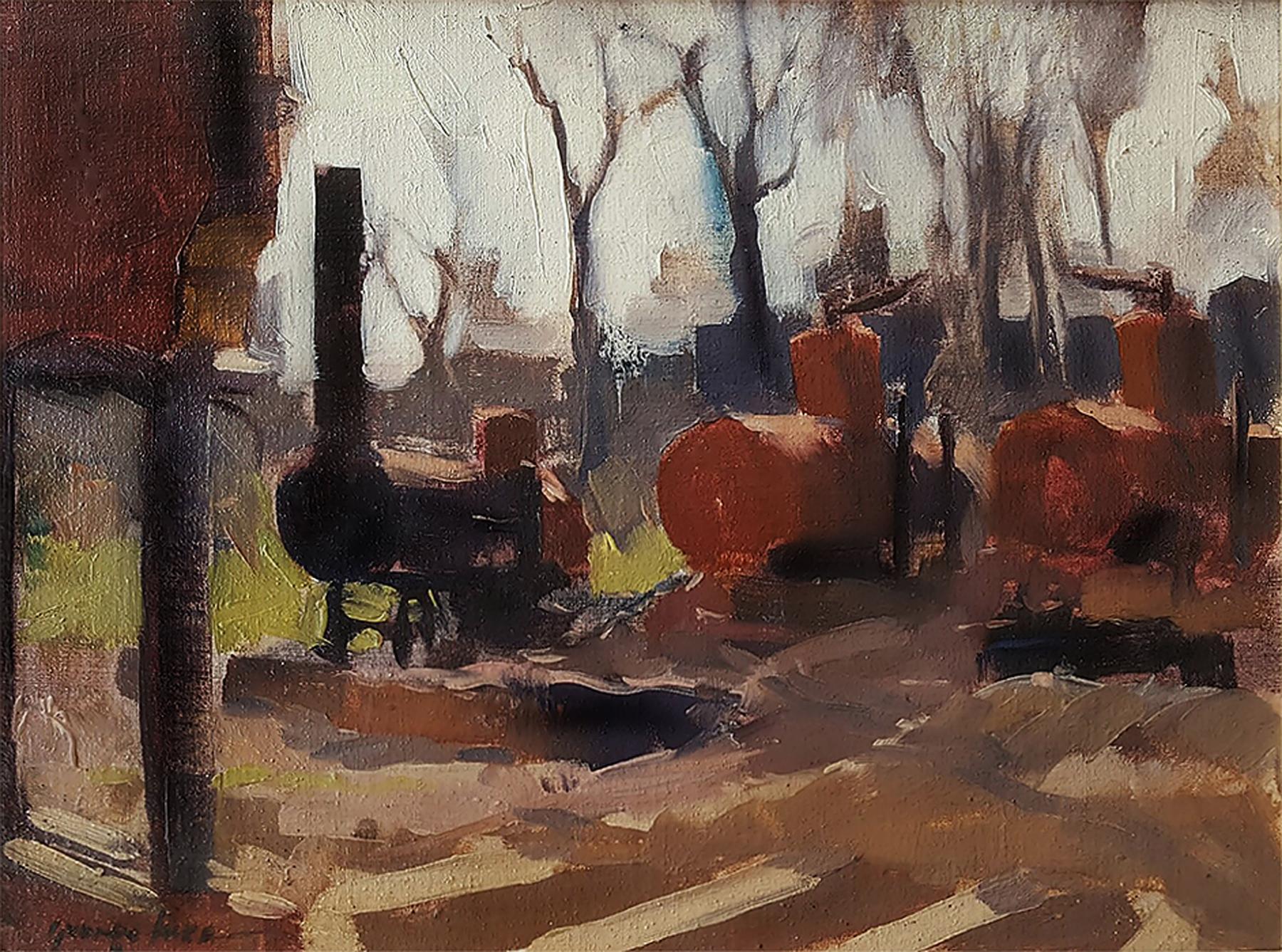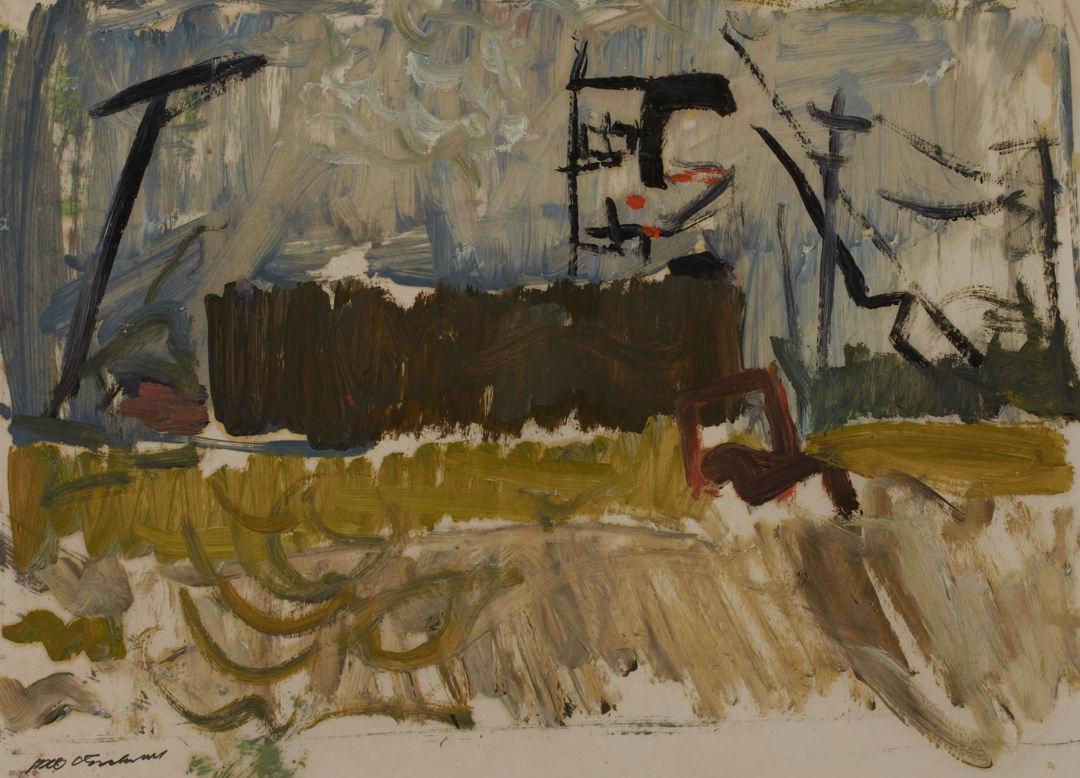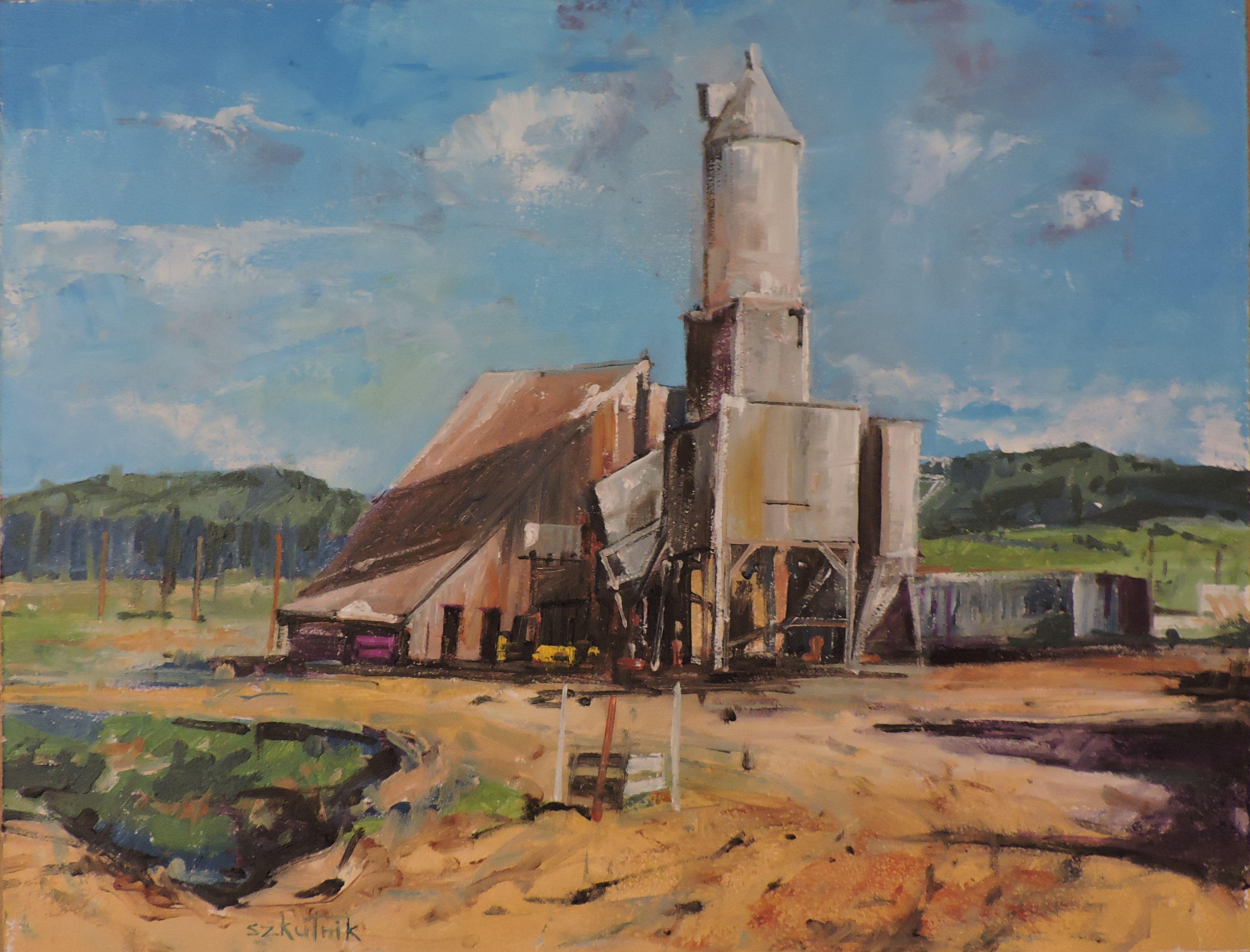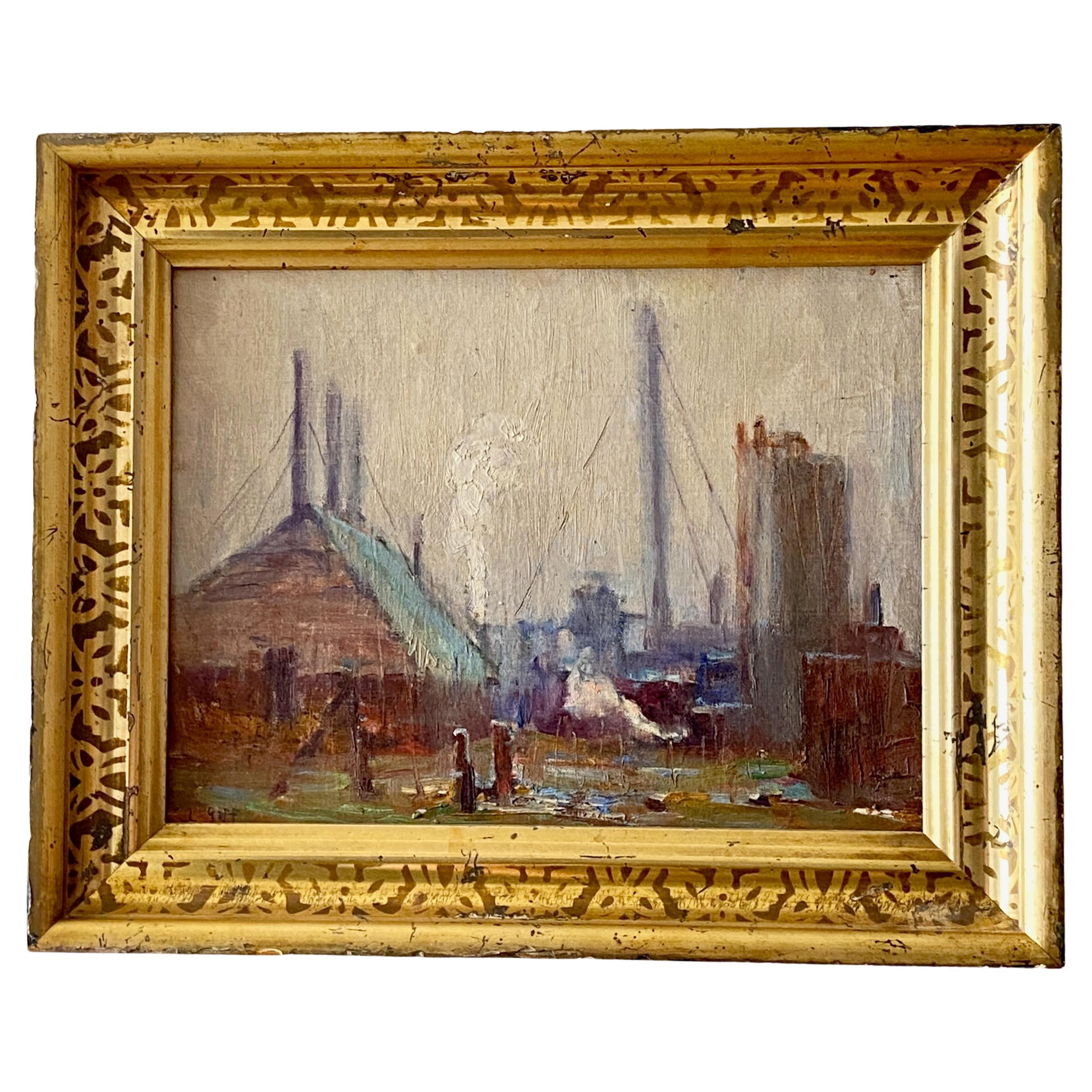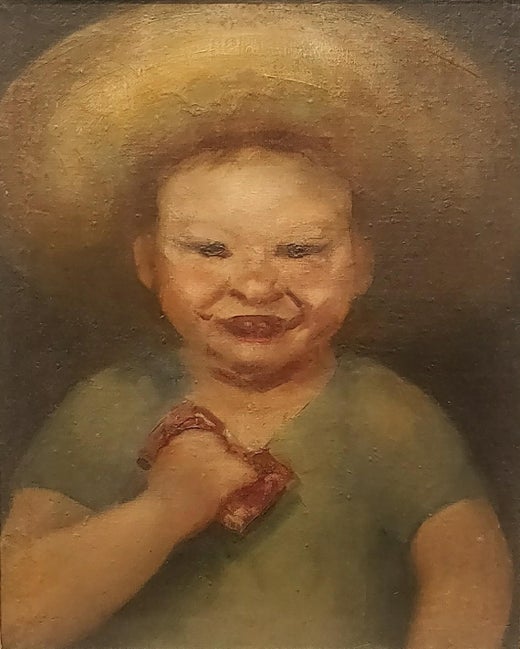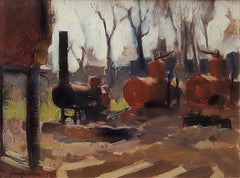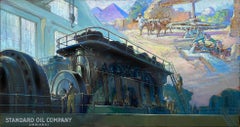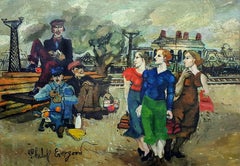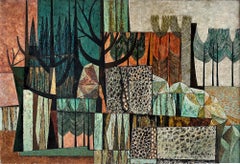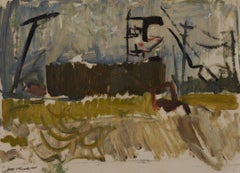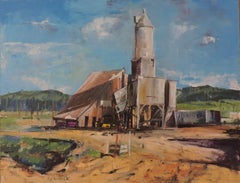Items Similar to Industrial Landscape
Want more images or videos?
Request additional images or videos from the seller
1 of 9
George LuksIndustrial Landscape1930's
1930's
$14,800
$18,50020% Off
£11,304.46
£14,130.5720% Off
€12,926.55
€16,158.1920% Off
CA$21,039.08
CA$26,298.8520% Off
A$23,074.75
A$28,843.4420% Off
CHF 12,067.59
CHF 15,084.4920% Off
MX$278,806.26
MX$348,507.8220% Off
NOK 151,413.94
NOK 189,267.4220% Off
SEK 142,725.96
SEK 178,407.4520% Off
DKK 96,477.48
DKK 120,596.8520% Off
About the Item
Quick and confident brush strokes describe the gritty forms of perhaps steam engines or railroad yards. Luks bravura style of putting paint to canvas anticipates action painting of the Abstract Expressionists who would follow Luks generations later. Sotheby's, New York, March 2005 Cigna Museum and Art Collection Exhibitions: Beyond the Liberty Bell, Philadelphia Art from the Cigna Museum,White Planes, New York, 10/30/1995 - 1/31/1996 Housed in a quality reproduction frame signed lower left
- Creator:George Luks (1867 - 1933, American)
- Creation Year:1930's
- Dimensions:Height: 12 in (30.48 cm)Width: 16 in (40.64 cm)
- Medium:
- Movement & Style:
- Period:
- Condition:
- Gallery Location:Miami, FL
- Reference Number:1stDibs: LU38533676202
George Luks
George Luks was an American realist painter and comic illustrator, best known for his images of New York City and its inhabitants. Born in Williamsport, Pennsylvania, Luks worked as a vaudeville performer before moving to Philadelphia to study art at the Pennsylvania Academy of the Fine Arts. He traveled through Europe, where he attended several art schools and developed a particular admiration for Diego Velázquez, Frans Hals, and Édouard Manet. Even before leaving for Europe, Luks was publishing comic illustrations in Puck and Truth, and upon his return in 1893 he accepted a job as a newspaper illustrator at the Philadelphia Press. In 1896, the Press sent him to Cuba as a special correspondent to cover the mounting tensions there. Working at the Press, Luks befriended Everett Shinn, William Glackens, John Sloan, and Robert Henri. In 1896 Luks moved to New York City and began to work as an illustrator for Joseph Pulitzer's New York World. He drew the comic strip Hogan's Alley after the strip’s originator Frederick Opper was lured away to William Randolph Hearst’s New York Journal. Though capable of picturesque urban scenes (like those that his friends Shinn and Glackens specialized in), Luks excelled as a broad comic artist, drawing single and multi-panel cartoons for newspapers and magazines, and working as a political cartoonist for the magazine Verdict. In the 1920s, Luks drew comic sketches for Vanity Fair and The New Yorker. As a painter, Luks found inspiration in New York City, often depicting the streets and denizens of the Lower East Side, subjects which gained him little favor with art critics and jurors steeped in the genteel tradition. He painted thickly, often laying his paint on the canvas with a palette knife. In 1907, the rejection of one of his canvasses from a juried exhibition at the National Academy of Design spurred the organization of a protest exhibition the following year at Macbeth Gallery. This watershed exhibition would become known as the exhibition of "The Eight" for the eight painters who collaborated to put it together. Known for his big personality and love of liquor, Luks was a vocal proponent of American painting in the early 20th century.

About the Seller
5.0
Gold Seller
Premium sellers maintaining a 4.3+ rating and 24-hour response times
Established in 2005
1stDibs seller since 2016
117 sales on 1stDibs
Typical response time: 1 hour
- ShippingRetrieving quote...Shipping from: Miami, FL
- Return Policy
Authenticity Guarantee
In the unlikely event there’s an issue with an item’s authenticity, contact us within 1 year for a full refund. DetailsMoney-Back Guarantee
If your item is not as described, is damaged in transit, or does not arrive, contact us within 7 days for a full refund. Details24-Hour Cancellation
You have a 24-hour grace period in which to reconsider your purchase, with no questions asked.Vetted Professional Sellers
Our world-class sellers must adhere to strict standards for service and quality, maintaining the integrity of our listings.Price-Match Guarantee
If you find that a seller listed the same item for a lower price elsewhere, we’ll match it.Trusted Global Delivery
Our best-in-class carrier network provides specialized shipping options worldwide, including custom delivery.More From This Seller
View AllIndustria Landscape - Post-Impressionist Brush Strokes
By George Benjamin Luks
Located in Miami, FL
Three engines sit in a wasted landscape described in a palate of warms grays, browns and ochers in broad quickly applied brush strokes.
Quick and confident brush strokes describe th...
Category
1910s Post-Impressionist Landscape Paintings
Materials
Oil, Board
Wheels of Industry Past and Present, Golden Age of Illustration - Standard Oil
Located in Miami, FL
This Golden Age of Illustration painting juxtaposes modern and ancient industrial practices. Giant eclectic generators from the current ti...
Category
Mid-20th Century Academic Landscape Paintings
Materials
Gouache, Board
$12,000 Sale Price
20% Off
Railroad Men's Wives - American Scene Painting - Social Realism
By Philip Evergood
Located in Miami, FL
American Scene Painting - Social Realism. The present work is a Depression Era account of working-class men and women.
Philip Howard Francis Dixon Evergood (born Howard Blashki; 190...
Category
1930s Expressionist Figurative Paintings
Materials
Oil
Landscape Abstraction - Mid-Century - Twenty Paintings in One
Located in Miami, FL
When it comes to abstract painting, the creation date is important. At the height of Abstraction Expressionism, overlooked Academic Artist John Atherton created a wonderfully complex painting that embodies many of the characteristics of what was going on in Mid-Century American Art. The work is simultaneously abstract as it is representational. Like a Bento Box, it's divided into sections by dividers. On close inspection, each section stands on it's own as a beautiful mini-painting yet coalesces as part of the whole. From a distance, it is eye-pleasing, but as the view gets closer and closer, new structures and details gloriously reveal themselves. This is an important painting and not unlike the work of Joaquín Torres-García. It was done in the last year of the artist's life. Signed lower right. Canvas is relined. Framed size: 30 x 41.25. The work is best viewed with top gallery lights to bring out color.
Color will look different under different lighting conditions. Atherton exhibited at the famous Julien Levy Gallery in New York and his fine art is mainly associated with Magic Realism. He participated in the seminal 1943 Museum of Modern Art exhibition, American Realists and Magic Realists. The Museum of Modern Art has 4 Atherton paintings in its collection. As an Illustrator, Atherton did covers for the Saturday Evening Post, Fortune and Holiday Magazine...
Category
1950s Abstract Expressionist Abstract Paintings
Materials
Canvas, Oil
City Scape Abstract Expressionist Composition -Jackson Pollack Friend
By Joseph Meert
Located in Miami, FL
The fame, notoriety, and monetary value of an artist's work in today's market are not based on one's talent and vision. Factors such as marketing and media momentum play a defining r...
Category
1940s Abstract Expressionist Abstract Paintings
Materials
Gouache, Board
Storm Composition #3
By Abraham Rattner
Located in Miami, FL
An early example of Abstract Expressionism executed in 1955 during the movement's heyday and it's period of peak inventiveness. However, this work is still rooted in representation. The dark area the runs along the base of the picture is the ground and to the left, right and center there are black structures that represent trees. The work is very tactile and is composed of globs of paint that grow out from the surface and form a thick impasto. Rich vibrant saturated blues, reds and oranges create optical drama. The work look better in person. frame: 29 x 39 1/2 inches , Provenance: Kennedy Galleries
The Currier Gallery of Art...
Category
1950s Abstract Expressionist Abstract Paintings
Materials
Oil
You May Also Like
20th Century Industrial Cityscape Oil painting, Cleveland School Artist
By Joseph O'Sickey
Located in Beachwood, OH
Work sold to benefit the CLEVELAND INSTITUTE OF ART
Joseph B. O’Sickey (American, 1918–2013)
Industrial Cityscape
Oil on paper
Signed lower left
13.75 x 16.5 inches
Joseph O'Sicke...
Category
Late 20th Century Post-Impressionist Landscape Paintings
Materials
Oil
Ohio Small No. 3, Industrial Scene, Acrylic, Wood Panel, Landscape, Buildings
By Ferdinanda Florence
Located in Riverdale, NY
Ohio Small No 3 is an industrial landscape painting by California artist Ferdinanda Florence. It is acrylic on wood. It is 7.25 x 9.5. It is filled with white, brown, yellow and green.
Ferdinanda Florence was born in Washington, DC, and grew up in Arlington, VA. She received a degree in art history and studio art at The American University in 1994, and has continued to pursue a successful professional life as a scholar, teacher, and practicing artist. She earned her Master’s degree in art history at the University of Maryland, College Park, in 1998.
A second-generation Armenian-America, Ferdinanda has explored in her research the role of place in artistic expression. Her Master’s thesis detailed the link between Armenian religious rituals and church architecture...
Category
2010s Contemporary Landscape Paintings
Materials
Wood, Acrylic
Industrial, Painting, Oil on Wood Panel
By Richard Szkutnik
Located in Yardley, PA
original plein air oil on panel :: Painting :: Impressionist :: This piece comes with an official certificate of authenticity signed by the artist :: Ready to Hang: No :: Signed: Yes...
Category
2010s Impressionist Paintings
Materials
Oil
The Abandoned Factory
By William Frates
Located in San Francisco, CA
This artwork titled "The Abandoned Factory" c.1945 is an oil painting on canvas by noted California artist William E. Frates, 1891-969 It is signed at the lower right corner by the artist. The canvas size is 24 x 30 inches, framed is 40.75 x 34.5 inches. Custom framed in a wooden gold brownish frame, with fabric liner. This particular artwork has been exhibited at the California Palace of the Legion of Honor Museum in San Francisco, August to April 1946.
About the artist:
Painter, etcher. Born in Hayward, CA in 1896. Frates first studied art in San Francisco with Wm Otto...
Category
Mid-20th Century American Impressionist Landscape Paintings
Materials
Oil
Lloyd Lozes Goff Industrial Landscape Painting, American 20th Century
Located in San Francisco, CA
Lloyd Lozes Goff painting of a rural industrial landscape in gilt wood frame.
Signed oil on board.
Lloyd Lozes Goff (1908–1982) was an American pai...
Category
Mid-20th Century American Paintings
Materials
Paint
$2,062 Sale Price
25% Off
Industry_
Located in Edinburgh, GB
Plein air
Category
2010s Impressionist Landscape Paintings
Materials
Canvas, Oil
More Ways To Browse
Vintage Industrial Art
Steam Engine
Liberty Bell
Edith White Still Life Painting
Empire State Building Painting
Estes Park
Garden Of The Gods
Gerald Harvey Jones
Gerald Harvey
Gregory West
Gulf Coast Paintings
Hampstead Heath
Hay Bales Painting
Henri Hayden
Heydenryk Frames
Hound Fox Hunting
Impressionist Farm Barn Painting
Indian Painting Signed
